For several years, we have been sending Santa our wish list for Manitoba. Some wishes came true while others remain perennial favourites. This year, it’s time to check our list twice, to see which ones remain wannabees and which ones came true!
1) Invest heavily in transit
This wish has topped our list every year for several years but, alas, no joy. Instead, we have seen declines in transit funding in the past two years. On the bright side, we now have a Winnipeg Transit Master Plan, which includes a complete overhaul of the network and approach to transit planning. But it needs funding to happen and needs to happen faster. The Province and City recently (and might I say, finally) submitted a federal funding proposal in November that will support a number of transit projects, including initial steps of the master plan.
2) Create and connect pedestrian & cycling infrastructure
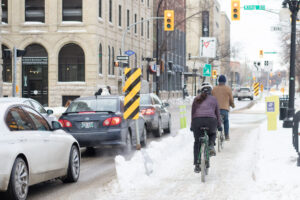 Another perennial favourite, this wish has varied from more (protected and connected) infrastructure, and redesigning and opening the Portage and Main intersection to pedestrians, to maintaining the Open Streets introduced in 2020 due to the pandemic. While improvements have been made, we have a long way to go before people of all ages and abilities feel safe using a bicycle to get around. The Pedestrian and Cycling Strategies adopted in 2014 are now under review, as part of the Transportation Master Plan 2050. The final phase of public engagement will take place in spring 2022, so we all have one more chance to have our say.
Another perennial favourite, this wish has varied from more (protected and connected) infrastructure, and redesigning and opening the Portage and Main intersection to pedestrians, to maintaining the Open Streets introduced in 2020 due to the pandemic. While improvements have been made, we have a long way to go before people of all ages and abilities feel safe using a bicycle to get around. The Pedestrian and Cycling Strategies adopted in 2014 are now under review, as part of the Transportation Master Plan 2050. The final phase of public engagement will take place in spring 2022, so we all have one more chance to have our say.
3) Turn policies into action
This is an ongoing issue but particularly apt in 2022, as the City of Winnipeg has recently undertaken reviews of existing plans or developed new policies, such as OurWinnipeg 2045, Complete Communities 2.0, Residential Infill Strategy, Transportation Master Plan 2050 and Pedestrian and Cycling Strategies update (in process), Parking Strategy (in process), and Winnipeg Transit Master Plan. And let’s not forget the Winnipeg Climate Action Plan, adopted in 2018. Whew! That’s a lot of plans. So where’s the action? And where is the connection to budget? As the adage goes, don’t look to a city’s mandate for its priorities, look to their budget. That’s where we need to see the change.
4) Pass and implement the United Nations Declaration on the Rights of Indigenous Peoples Act
 Joy at last! On June 21, 2021, the United Nations Declaration on the Rights of Indigenous Peoples Act, received Royal Assent and became law in Canada. However, it needs to be noted that many Indigenous peoples struggled with supporting Bill C-15. Now comes the tricky and the truthful part – implementation.
Joy at last! On June 21, 2021, the United Nations Declaration on the Rights of Indigenous Peoples Act, received Royal Assent and became law in Canada. However, it needs to be noted that many Indigenous peoples struggled with supporting Bill C-15. Now comes the tricky and the truthful part – implementation.
Our fervent wish is for action that exceeds progress on the 94 Calls to Action from the National Truth and Reconciliation Commission. Been wondering what’s happened with those? We strongly endorse checking out Beyond 94, an update compiled by the CBC. Green Action Centre dedicates time at each staff meeting to discuss learnings on diversity and inclusion, which included several discussions on Beyond94 TRC Calls to Action. Totally worthwhile.
In related news, September 30th this year marked the first National Truth and Reconciliation Day in Canada in conjunction with Orange Shirt Day (Every Child Matters). What a spectacular sight in Winnipeg as a sea of orange made its way down Main St. from The Forks to St. John’s Park.
5) Take a regional approach to transportation and provide viable intercommunity transport
You might be wondering why we keep coming back to transportation. Well… transportation is the biggest contributor of GHG emissions in Manitoba and the bulk of that is made up by personal transportation. That’s all of us. How we get around and between our communities is key.
 The Winnipeg Metropolitan Region completed its Plan 20-50 which has been submitted to the Province for approval. Future plans include creation of a Capital Region Planning Board. The future of transportation in the metro region will be determined by this plan and Winnipeg’s Transportation Master Plan 2050.
The Winnipeg Metropolitan Region completed its Plan 20-50 which has been submitted to the Province for approval. Future plans include creation of a Capital Region Planning Board. The future of transportation in the metro region will be determined by this plan and Winnipeg’s Transportation Master Plan 2050.
But how can Manitobans get between communities now with Greyhound long gone and limited private options available? Sadly, the idea that the private sector would step up and fill the gap has not happened. It’s a hard service to make viable for any provider, which is why it was subsidized in the past. It is another highlight of the transportation inequities and injustices faced by any Manitoban unable to drive or own a car, or simply wanting a sustainable option. To help address this barrier, Green Action Centre launched GoManitoba, an online ridematching tool that helps users find carpool matches or mentors to assist with getting around by bike or transit for the first time.
6) Implement curbside compost collection and increase opportunities for multi-family composting
Ah, the never ending saga of curbside composting pickup. Another perennial favourite on our wish list, it remains a future dream in Winnipeg but a wonderful reality in other Manitoba municipalities such as Brandon and Morden. On the bright side, a pilot program launched in Winnipeg in 2020 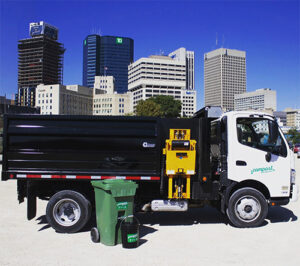 with approximately 4,000 households in five neighbourhoods. The pilot ends in spring 2023, after which results will be analyzed and consideration given whether to roll it out city-wide. This translates into another few years of work, meaning we won’t likely see a city-wide program until 2026 at the earliest.
with approximately 4,000 households in five neighbourhoods. The pilot ends in spring 2023, after which results will be analyzed and consideration given whether to roll it out city-wide. This translates into another few years of work, meaning we won’t likely see a city-wide program until 2026 at the earliest.
Green Action Centre inadvertently helped fill the gap after the City of Winnipeg reneged on its initial green cart program in 2014. Our social enterprise, Compost Winnipeg, was initially focused on organic waste pickup from commercial or business clients but stepped up to absorb a number of new residential clients (in both single dwelling homes and apartments or condos). The growth for residential pickup has been phenomenal ever since. Glad we were there at the right time and the right place!
7) Ban organics in landfills by 2022
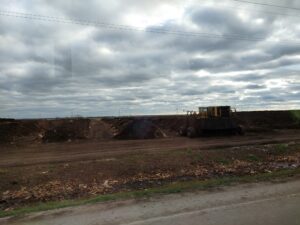 Yup, you guessed it, another perennial favourite on our wish list but this one is for the Province of Manitoba. While residential curbside composting at the municipal level is a key structural element, motivation is needed to reduce the amount of organic waste in our landfills. At present, compostable materials make up about 40% of total waste in landfills and result in the creation of methane, a greenhouse gas that is 25 times more potent than carbon dioxide.
Yup, you guessed it, another perennial favourite on our wish list but this one is for the Province of Manitoba. While residential curbside composting at the municipal level is a key structural element, motivation is needed to reduce the amount of organic waste in our landfills. At present, compostable materials make up about 40% of total waste in landfills and result in the creation of methane, a greenhouse gas that is 25 times more potent than carbon dioxide.
This year, the Province released a report on the Manitoba Waste Diversion and Recycling Framework Review. The review notes that addressing organic waste at landfills would have the greatest impact on reducing GHG emissions.
8) Minimize food waste
Here’s one for all of us! Organic waste, both avoidable and unavoidable, makes up about 30% of residential trash. Food loss and waste is a significant contributor to commercial and industrial waste streams, as well. We’re big fans of composting, but even better is stopping the waste at the source and preventing avoidable waste. At the household level, every family can benefit from this – it is estimated that $1,200 a year of food ends up in the trash per household. What can you do to take action on this today? Try a personal waste audit or reduce your waste with a pantry challenge.
9) Implement a ban on single-use plastics
 Finally, a wish that is coming true. Federal regulations on the ban of six types of single-use plastics were released this week. Some cities and retailers had moved ahead of the federal regulations by introducing their own bans, such as Sobeys switching to reusable or paper bags only, and some food outlets replacing plastic straws with paper versions.
Finally, a wish that is coming true. Federal regulations on the ban of six types of single-use plastics were released this week. Some cities and retailers had moved ahead of the federal regulations by introducing their own bans, such as Sobeys switching to reusable or paper bags only, and some food outlets replacing plastic straws with paper versions.
Since 2018, Green Action Centre has partnered with Red River Co-op grocery stores to reduce waste. Through an education and awareness campaign for customers and staff as well as the introduction of a 5-cent fee per bag, Red River Co-op was able to reduce the disposable bags used in their stores by 54%, diverting over 3 million bags from the landfill in just one year. Profits from the bag sales were donated to Green Action Centre’s composting initiatives in 2019, and food waste and plastic reduction efforts in 2020.
10) Direct carbon tax revenue to reducing GHG emissions
Since the Province of Manitoba scrapped the carbon tax portion of Manitoba’s Climate and Green Plan in 2018, our wish is that the federal government keeps the backstop in place but also directs funds to green solutions for all Manitobans. We believe carbon revenues should be targeted toward technologies and programs that reduce or mitigate GHG emissions directly or provide alternatives to current practices, while low-income groups and other disadvantaged people in Manitoba should be protected to alleviate the impact of the tax. Learn more in our brief to the Province [pdf].
11) Prioritize transportation modes to create a shift
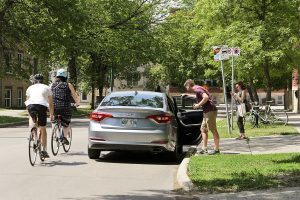 We’re probably singing to the choir here, but a key element of reducing GHG emissions is shifting travel modes from driving alone to using public transit (where available), carpooling, cycling or walking for more trips. This is where land use and transportation planning go hand in hand – more compact communities make it possible to get around on foot or by bike while a robust transit network provides a sustainable way to travel further distances. But, to date, our planning has continued to make it easier, more convenient and not much more expensive to drive (if you exclude the cost of buying a vehicle).
We’re probably singing to the choir here, but a key element of reducing GHG emissions is shifting travel modes from driving alone to using public transit (where available), carpooling, cycling or walking for more trips. This is where land use and transportation planning go hand in hand – more compact communities make it possible to get around on foot or by bike while a robust transit network provides a sustainable way to travel further distances. But, to date, our planning has continued to make it easier, more convenient and not much more expensive to drive (if you exclude the cost of buying a vehicle).
A mode shift means we need to prioritize sustainable modes and make them just as (or more) appealing than driving alone. Sadly, the current draft of the Winnipeg Transportation Master Plan 2050 does not prioritize sustainable modes even though it recognizes that we can’t afford to continue building new roads (when we can’t afford to maintain our existing network), and we need to increase the number of trips made by bus, cycling, walking or carpooling to meet our goals as a city. Guess we’re just hoping people will “do the right thing”.
12) Increase active travel by youth
 Let’s end on an upbeat note. (Okay, potentially.) Since 2016, we’ve been looking for mandatory school travel planning to increase the number of children walking and cycling to school in Manitoba and an expansion of cycling skills education in all schools. Both of these look bright, as they are included in the draft Winnipeg Transportation Master Plan 2050. We were hoping for provincial requirements for all schools across the province but it’s a start.
Let’s end on an upbeat note. (Okay, potentially.) Since 2016, we’ve been looking for mandatory school travel planning to increase the number of children walking and cycling to school in Manitoba and an expansion of cycling skills education in all schools. Both of these look bright, as they are included in the draft Winnipeg Transportation Master Plan 2050. We were hoping for provincial requirements for all schools across the province but it’s a start.
Brand new for 2022: We wish that all of the inequities and injustices exposed by the epidemic – health, income, mobility, access to green space – will not be forgotten or swept under the rug as we struggle to learn to live with COVID-19. Our hearts go out to everyone who has suffered heartache and loss in their lives.
 And one more thing! Green Action Centre wishes all Manitobans a safe and eco-filled 2022, complete with healthy food, healthy transportation, and green living practices. Let’s see what we can make happen this year.
And one more thing! Green Action Centre wishes all Manitobans a safe and eco-filled 2022, complete with healthy food, healthy transportation, and green living practices. Let’s see what we can make happen this year.

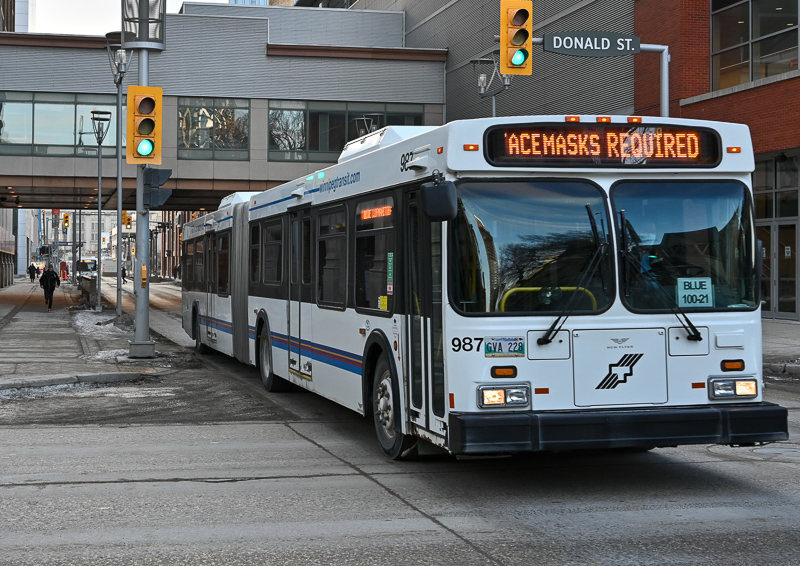


Recent Comments